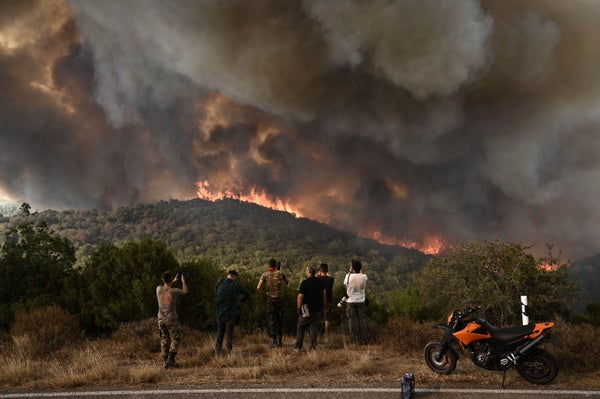August 16, 2024
3 min read
Climate Change Made 2023’s Wildfire Season So Much Worse
Global warming made hot, dry weather that fuels wildfires more likely in places such as Canada, Greece and the Amazon rainforest last year, new research says

People look at the wildfire raging in a forest in Sikorahi, near Alexandroupoli, northern Greece, on August 23, 2023.
Sakis Mitrolidis/AFP via Getty Images
CLIMATEWIRE | Wildfires burned 1.5 million square miles of land around the world from March 2023 through February 2024, spewing 8.6 billion metric tons of carbon dioxide into the atmosphere.
And climate change helped fuel the destruction, scientists say.
Blazes in Canada, which saw its worst fire season on record, burned up nearly 58,000 square miles — 40 percent more land than would have burned in a world without global warming. And the dry, windy weather that made it possible was at least three times more likely to occur because of climate change.
On supporting science journalism
If you’re enjoying this article, consider supporting our award-winning journalism by subscribing. By purchasing a subscription you are helping to ensure the future of impactful stories about the discoveries and ideas shaping our world today.
In Greece, where Europe’s largest wildfire on record erupted last year, the burned area was 18 percent higher because of climate change. The fire weather there was at least twice as likely to occur.
And in the western Amazon rainforest, the burned area was as much as 50 percent larger because of climate change, while the fire weather was at least 20 times more likely to occur.
That’s according to a new report on the past year’s global wildfire season, released Wednesday by a consortium of research institutes including the U.K.’s Met Office, University of East Anglia, UK Centre for Ecology and Hydrology, and European Centre for Medium-Range Weather Forecasts. It’s the first edition of the report, which will be published annually.
“Last year, we saw wildfires killing people, destroying properties and infrastructure, causing mass evacuations, threatening livelihoods, and damaging vital ecosystems,” said lead report author Matthew Jones, a research fellow at the Tyndall Centre for Climate Change Research at the University of East Anglia, in a statement. “Wildfires are becoming more frequent and intense as the climate warms, and both society and the environment are suffering from the consequences.”
The new report examines wildfires across the globe, using satellite observations and models to monitor burned area and estimate the amount of carbon dioxide released into the atmosphere. It finds that last year’s fire emissions were 16 percent higher than average — and they likely would have broken an all-time record if not for an unusually quiet fire season across the world’s grassy savannas.
North America had an especially severe season last year, the report adds, accounting for about a quarter of the entire planet’s fire emissions. Much of that CO2 came from the record-breaking blazes in Canada, where emissions were about nine times higher than average.
The report also zooms in on some of the past season’s most extreme regional examples, including Canada, Greece and the Amazon, which all experienced record-breaking seasons.
The blazes in Canada burned six times more land than average, prompting evacuations of more than 200,000 people and killing at least eight firefighters. The Evros fire in Greece, which sprang up near the border of Turkey in August 2023, was the largest ever seen on the European continent and killed at least 20 people after burning an area larger than New York City.
Much of South America, meanwhile, experienced lower-than-average fire activity — except for parts of the Brazilian Amazon and neighboring areas of Venezuela, Bolivia and Colombia, where fire counts hit record highs. Chile also experienced one of its deadliest blazes on record when wildfires scorched its Valparaíso region in February 2024, killing more than 100 people.
Wildfires are notoriously complex phenomena, the report notes, heavily influenced by both climate factors and human activities. In Canada and Greece, the research team found, the extreme wildfires might have been even worse if not for human land-use factors such as agriculture, forest management and fragmentation of the natural landscape. Severe fire weather and large quantities of dry fuel were the biggest risk factors in both places.
In the Amazon, on the other hand, human activities — including widespread deforestation — likely worsened the blazes. Severe drought and intense heat, partly intensified by an unusually powerful El Niño event, also were factors in last year’s season.
In all three places, though, the researchers found that climate change worsened the hot, dry conditions that helped the fires spread. And those conditions only will intensify as global temperatures continue to climb.
The researchers used specialized climate models to investigate how regional fire seasons might evolve as the planet heats up. They found that the likelihood of fire seasons as severe as last year’s events will increase significantly in Canada, Greece and the Amazon under even moderate future climate change scenarios.
But strong climate action can make a difference, the report adds. Milder future scenarios — assuming humans quickly curb their global greenhouse gas emissions — could significantly reduce the risks of such events in the coming decades.
Reprinted from E&E News with permission from POLITICO, LLC. Copyright 2024. E&E News provides essential news for energy and environment professionals.








